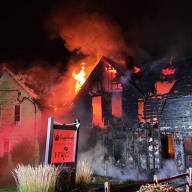When Warren native Will Robinson set out to hike the northeast’s 115 4,000-foot peaks last June, he had more challenges ahead of him than he realized.
Robinson, a preschool teacher now living in Middlebury, noted that he initially started trying to figure out a route for a through-hike of the peaks a couple of years ago, and after finding out another person had done the route on both bike and foot, he decided to make a concrete plan. Robinson noted that his was the first known through-hike of the 115 northeast 4,000-footers.
The total route was about 1,300 miles, Robinson said, and he started on June 16 once school let out. His mother drove him down to the Catskills, where he completed summits of Slide Mountain and Hunter Mountain, the Catskills’ only two 4,000-foot peaks. From there, it was a long walk along the road up to Northville, New York, traversing shoulders “of varying width.” During this part of the hike, he was able to stay at his mother’s home at night, as she would pick him up and then drop Robinson off at the same point to resume his walk the next day.
This portion of the trek was, for Robinson, “incredibly uneventful,” and it was tough to slog on each day knowing how far he had to go and that only two of 115 mountains had been checked off the list. At Northville, he got onto the Northville-Placid Trail to head toward the Adirondacks. This saved him 100 miles of road walking – and he saw a bear. But it was lonely, he said, with no other through-hikers for camaraderie.
ZERO AND NERO DAYS
And, said Robinson, “I had done some training leading up to it, but apparently not enough.” His quads were feeling the effort, “to the point where any up- or downhill, I just felt like my legs were going to give out underneath me." A couple of days’ rest helped.
“I took one zero (a day without hiking any miles) and one nero (nearly-zero miles in one day) to take care of the quads,” Robinson said. “They were separated by probably about a week or a week and a half or so.”
Another challenge arose when Robinson noticed blood in his urine. He was able to reach a friend who is a nurse for advice, and while the friend suggested that he ought to seek medical attention, the issue went away within about 72 hours. It happened again periodically, Robinson said.
Robinson’s mother came to join him on the crossing from New York into Vermont, he said. She also helped throughout the trip with supplies, so he had seen her before this, "but it still felt really good to cross over into Vermont. It's where I grew up, where I'm from. It felt good just to cross the state line and leave the Adirondacks and New York behind me because they had put me through so much.” But the joy was short-lived.
“And then I got into Vermont and that’s when the flooding starts basically,” Robinson said. July’s historic flooding turned out not to have a significant impact on his journey, as he was largely on roads during this section and only hit one washed-out area. But at the same time, Robinson also didn't find much-hoped-for through-hiking companions on the Long Trail.
LONG TRAIL
"The day that I get on the Long Trail is the day that GMC, the Green Mountain Club, was suggesting for people to get off the trail because they didn't know what trail conditions were like," Robinson said. So, the walk remained a largely lonely one.
Things changed as he crossed into New Hampshire, though. The weather improved, more companions were to be found on the trails, and some even began to recognize him from his social media posts about his trek. He hit the White Mountain Direttissima, a very direct route that Robinson knew and felt comfortable with. And the Maine portion of the journey, started on day 46, largely overlapped with the Appalachian Trail, with many other hikers on their own long journeys. This, Robinson said, was where he found his trail family – or “tramily.”
“I really actually was able to find my little tramily for a while,” and the group often ended their days in the same camps or hostel. It was a marked difference from the earlier days of the hike, when, said Robinson, he’d had real doubts about through-hiking.
TENT TALKS
“Going back and watching some of the videos that I took of myself in my tent each night – I called them my tent talks – I just look so miserable, and I feel so separated from that person,” Robinson said. “I’m like, that person isn't going to finish their hike. They're not going to because they're too miserable."
But he did. Robinson reached the end of the journey at Katahdin 59 and a half days in, on August 14. It feels different from what he would have expected, he said.
“I don’t feel a sense of accomplishment that I really was expecting to feel after such a big feat. I realize what I did is really big and really cool. I'm really proud of myself now that I did it, but I don’t necessarily feel accomplished. I don't know. I don't feel like I did it yet. Maybe it'll sink in over time.”
In addition to Robinson’s quads and occasionally his mood, other casualties of the trip included two trekking poles and four pairs of trail-running shoes.
But there were upsides despite the difficult days.
"I feel like what I learned is something very cliche, that it's about the journey, not necessarily the destination,” Robinson said. “I put so much focus on just the finish, just gotta get there to Katahdin, like it's all an approach trail to Katahdin, and it was, I think, the reason I didn't feel anything special when I got there – was because the trip was everything in between. It wasn't just the finish and I was really putting too much pressure on the finish . . . try to enjoy things before I get to the end."












